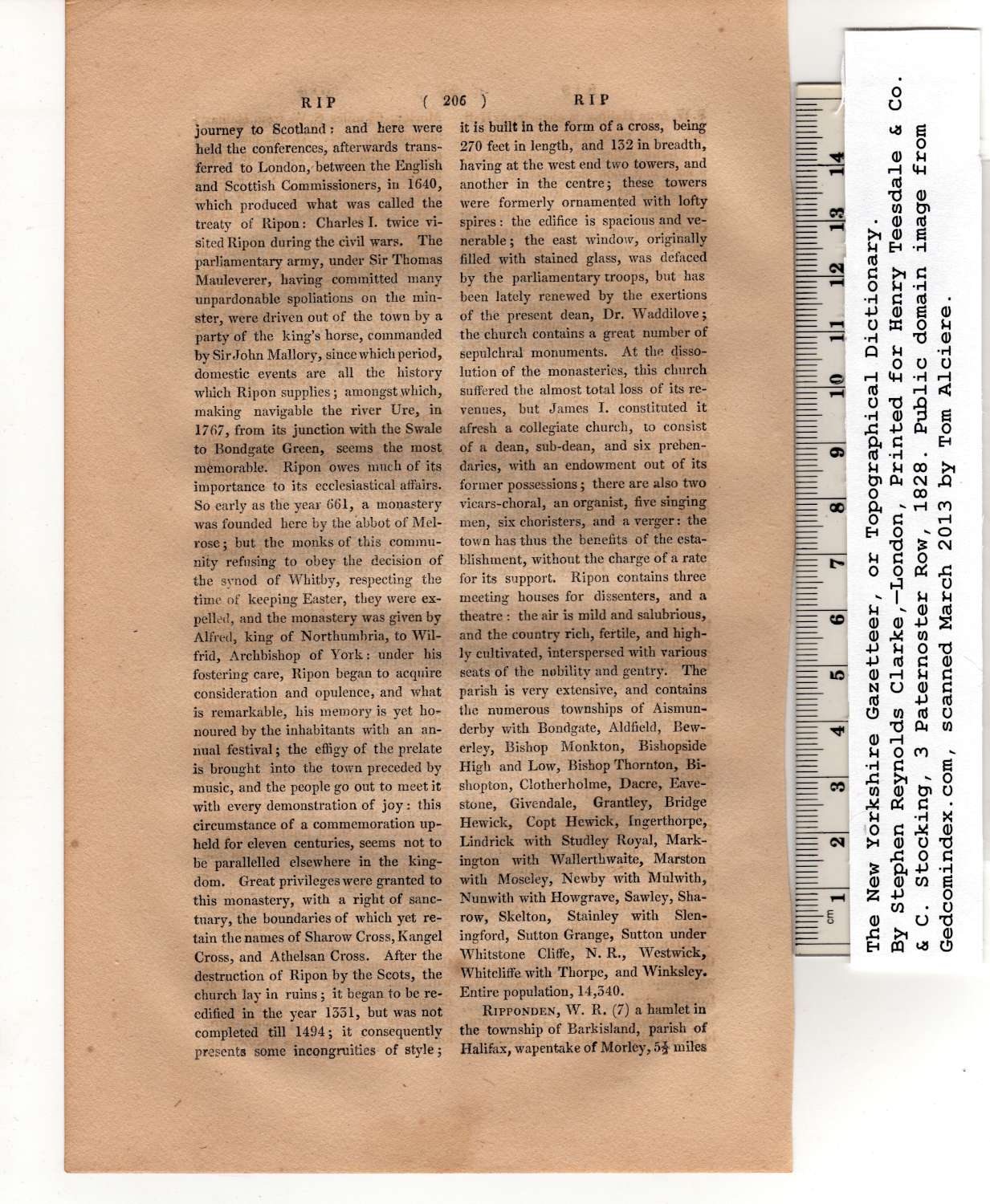|
journey to Scotland: and here were
held the conferences, afterwards trans-
ferred to London, between the English
and Scottish Commissioners, in 1640,
which produced what was called the
treaty of Ripon: Charles I. twice vi-
sited Ripon during the civil wars. The
parliamentary army, under Sir Thomas
Mauleverer, having committed many
unpardonable spoliations on the min-
ster, were driven out of the town by a
party of the king’s horse, commanded
by Sir John Mallory, since which period,
domestic events are all the history
which Ripon supplies; amongst which,
making navigable the river Ure, in
1767, from its junction with the Swale
to Bondgate Green, seems the most
memorable. Ripon owes much of its
importance to its ecclesiastical affairs.
So early as the year 661, a monastery
was founded here by the abbot of Mel-
rose ; but the monks of this commu-
nity refusing to obey the decision of
the synod of Whitby, respecting the
time of keeping Easter, they were ex-
pelled, and the monastery was given by
Alfred, king of Northumbria, to Wil-
frid, Archbishop of York: under his
fostering care, Ripon began to acquire
consideration and opulence, and what
is remarkable, his memory is yet ho-
noured by the inhabitants with an an-
nual festival; the effigy of the prelate
is brought into the town preceded by
music, and the people go out to meet it
with every demonstration of joy: this
circumstance of a commemoration up-
held for eleven centuries, seems not to
be parallelled elsewhere in the king-
dom. Great privileges were granted to
this monastery, with a right of sanc-
tuary, the boundaries of which yet re-
tain the names of Sharow Cross, Kangel
Cross, and Athelsan Cross. After the
destruction of Ripon by the Scots, the
church lay in ruins; it began to be re-
edified in the year 1331, but was not
completed till 1494; it consequently
presents some incongruities of style; |
it is built in the form of a cross, being
270 feet in length, and 132 in breadth,
having at the west end two towers, and
another in the centre; these towers
were formerly ornamented with lofty
spires: the edifice is spacious and ve-
nerable ; the east window, originally
filled with stained glass, was defaced
by the parliamentary troops, but has
been lately renewed by the exertions
of the present dean, Dr. Waddilove;
the church contains a great number of
sepulchral monuments. At the disso-
lution of the monasteries, this church
suffered the almost total loss of its re-
venues, but James I. constituted it
afresh a collegiate church, to consist
of a dean, sub-dean, and six preben-
daries, with an endowment out of its
former possessions; there are also two
vicars-choral, an organist, five singing
men, six choristers, and a verger: the
town has thus the benefits of the esta-
blishment, without the charge of a rate
for its support. Ripon contains three
meeting houses for dissenters, and a
theatre : the air is mild and salubrious,
and the country rich, fertile, and high-
ly cultivated, interspersed with various
seats of the nobility and gentry. The
parish is very extensive, and contains
the numerous townships of Aismun-
derby with Bondgate, Aldfield, Bew-
erley, Bishop Monkton, Bishopside
High and Low, Bishop Thornton, Bi-
shopton, Clotherholme, Dacre, Eave-
stone, Givendale, Grantley, Bridge
Hewick, Copt Hewick, Ingerthorpe,
Lind rick with Studley Royal, Mark-
ington with Wallerthwaite, Marston
with Moseley, Newby with Mulwith,
Nunwith with Howgrave, Sawley, Sha-
row, Skelton, Stainley with Slen-
ingford, Sutton Grange, Sutton under
Whitstone Cliffe, N. R., Westwick,
Whitcliffe with Thorpe, and Winksley.
Entire population, 14,340.
Ripponden, W. R. (7) a hamlet in
the township of Barkisland, parish of
Halifax, wapentake of Morley, 5£ miles |
